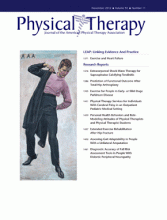Abstract
Background Diabetic peripheral neuropathy affects nearly half of individuals with diabetes and leads to increased fall risk. Evidence addressing fall risk assessment for these individuals is lacking.
Objective The purpose of this study was to identify which of 4 functional mobility fall risk assessment tools best discriminates, in people with diabetic peripheral neuropathy, between recurrent “fallers” and those who are not recurrent fallers.
Design A cross-sectional study was conducted.
Setting The study was conducted in a medical research university setting.
Participants The participants were a convenience sample of 36 individuals between 40 and 65 years of age with diabetic peripheral neuropathy.
Measurements Fall history was assessed retrospectively and was the criterion standard. Fall risk was assessed using the Functional Reach Test, the Timed “Up & Go” Test, the Berg Balance Scale, and the Dynamic Gait Index. Sensitivity, specificity, positive and negative likelihood ratios, and overall diagnostic accuracy were calculated for each fall risk assessment tool. Receiver operating characteristic curves were used to estimate modified cutoff scores for each fall risk assessment tool; indexes then were recalculated.
Results Ten of the 36 participants were classified as recurrent fallers. When traditional cutoff scores were used, the Dynamic Gait Index and Functional Reach Test demonstrated the highest sensitivity at only 30%; the Dynamic Gait Index also demonstrated the highest overall diagnostic accuracy. When modified cutoff scores were used, all tools demonstrated improved sensitivity (80% or 90%). Overall diagnostic accuracy improved for all tests except the Functional Reach Test; the Timed “Up & Go” Test demonstrated the highest diagnostic accuracy at 88.9%.
Limitations The small sample size and retrospective fall history assessment were limitations of the study.
Conclusions Modified cutoff scores improved diagnostic accuracy for 3 of 4 fall risk assessment tools when testing people with diabetic peripheral neuropathy.
Footnotes
All authors provided concept/idea/research design. Dr Jernigan, Dr Kluding, and Dr Mahnken provided writing. Dr Jernigan provided data collection, fund procurement, and clerical/secretarial support. Dr Jernigan and Dr Mahnken provided data analysis. Dr Jernigan and Dr Kluding provided project management. Dr Kluding provided study participants, facilities/equipment, and institutional liaisons. Dr Kluding, Dr Mahnken, and Dr Pohl provided consultation (including review of manuscript before submission). The authors thank Dr Mamatha Pasnoor and Dr Wen Liu, who provided guidance and consultation; Laura Herbelin and Jason Rucker, PT, who provided data collection assistance; and Mary Beth Fisher, ANP-BC, MSN, RN, CDE, and Kim Wernel, RD, LD, CDE, who provided participant recruitment assistance.
This study was approved by the Human Subjects Committee, University of Kansas Medical Center.
A poster presentation of some of the data was given at the Combined Sections Meeting of the American Physical Therapy Association; February 9–12, 2011; New Orleans, Louisiana. A platform presentation of some of the data also was given at the Kansas Physical Therapy Association Spring Conference; April 8–9, 2011; Wichita, Kansas.
This work was supported, in part, by University of Kansas Medical Center General Clinical Research Center grant M01 RR 02394, the National Center for Research Resources/National Institutes of Health, Frontiers: The Heartland Institute for Clinical and Translational Research (University of Kansas Medical Center's CTSA [UL1RR033179]), and Kansas Partners in Progress.
The contents of this article are solely the responsibility of the authors and do not necessarily represent the official views of the National Institutes of Health.
- Received February 22, 2012.
- Accepted July 23, 2012.












